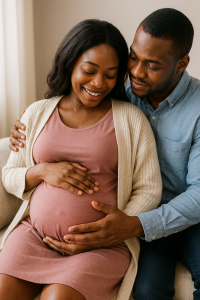The Science of Pregnancy: A Journey from Conception to Birth

Pregnancy is a biological marvel, a process where a single fertilized cell grows into a fully formed human being over the course of approximately 40 weeks. This transformation is driven by complex biological processes, guided by genetics, hormones, and cellular development.
In this article, we explore the science behind pregnancy, breaking down each stage and the intricate mechanisms that sustain new life.
1. Conception: The Beginning of Life
Pregnancy begins when a sperm cell from the father fertilizes an egg cell from the mother. This process, called fertilization, usually occurs in the fallopian tube within 24 hours after ovulation.
🔬 Key Scientific Events in Conception:
The sperm swims through the uterus and meets the egg in the fallopian tube.
Once a sperm penetrates the egg, their genetic materials (DNA) combine to form a zygote (a single-cell embryo).
The zygote immediately starts dividing, forming multiple cells as it travels toward the uterus.
Within a few days, the zygote becomes a blastocyst, a small ball of rapidly dividing cells, which implants into the uterus, marking the official start of pregnancy.
2. The Three Trimesters of Pregnancy
Pregnancy is divided into three trimesters, each with distinct biological and developmental milestones.
First Trimester (Weeks 1-12): The Foundation of Life
During this critical stage, the baby’s major organs and systems begin forming.
🧬 Key Developments:
✔️ The heart starts beating around week 5-6.
✔️ The brain, spinal cord, and nervous system begin to develop.
✔️ Limb buds (which become arms and legs) appear.
✔️ The placenta forms to provide oxygen and nutrients to the baby.
During this period, the risk of miscarriage is highest, as the body determines if the pregnancy is viable.
Second Trimester (Weeks 13-26): Rapid Growth and Movement
The second trimester is marked by fetal growth and increased movement. At this stage, the pregnancy becomes more stable.
🧬 Key Developments:
✔️ The baby starts making facial expressions and begins sucking their thumb.
✔️ Sex organs become visible through ultrasound.
✔️ The baby begins to hear sounds from outside the womb.
✔️ The lungs and digestive system continue to mature.
Pregnant individuals often feel fetal movement for the first time, commonly referred to as “quickening.”
Third Trimester (Weeks 27-40): Final Preparations for Birth
The final stage of pregnancy is about growth, fat accumulation, and lung development to prepare for survival outside the womb.
🧬 Key Developments:
✔️ The baby gains weight rapidly.
✔️ The brain undergoes significant development, increasing in complexity.
✔️ The lungs produce surfactant, a substance that helps them expand for breathing after birth.
✔️ The baby shifts into a head-down position in preparation for delivery.
By week 37, the pregnancy is considered full-term, and birth can occur at any time.
3. The Role of Hormones in Pregnancy
Hormones play a crucial role in supporting pregnancy and fetal development.
Key Pregnancy Hormones:
1️⃣ hCG (Human Chorionic Gonadotropin): The “pregnancy hormone,” responsible for maintaining the early pregnancy and detected in pregnancy tests.
2️⃣ Progesterone: Helps maintain the uterine lining and prevents contractions too early in pregnancy.
3️⃣ Estrogen: Supports fetal development and increases blood flow to the placenta.
4️⃣ Relaxin: Helps loosen the ligaments and joints in preparation for labor.
5️⃣ Oxytocin: The hormone responsible for triggering labor contractions and promoting bonding after birth.
4. The Placenta: The Lifeline Between Mother and Baby
The placenta is a unique organ that develops only during pregnancy. It connects the baby to the mother’s bloodstream, providing oxygen, nutrients, and antibodies while removing waste.
🌱 Functions of the Placenta:
✔️ Supplies oxygen and removes carbon dioxide.
✔️ Transfers nutrients like glucose, iron, and amino acids.
✔️ Produces key pregnancy hormones.
✔️ Acts as a barrier against infections.
By the end of pregnancy, the placenta weighs about 1 pound (450 grams) and is expelled after childbirth.
5. Labor and Childbirth: The Grand Finale
As pregnancy reaches full term, the body prepares for labor, the process of delivering the baby.
Stages of Labor:
1️⃣ Early Labor: The cervix begins to dilate, and mild contractions start.
2️⃣ Active Labor: Stronger contractions push the baby downward, and the cervix dilates to 10 cm.
3️⃣ Delivery: The baby moves through the birth canal and is born.
4️⃣ Placental Delivery: The placenta detaches and exits the body.
Throughout labor, the hormone oxytocin drives contractions and helps with mother-baby bonding after birth.
Conclusion: The Science Behind the Miracle
Pregnancy is a biological masterpiece, blending genetics, hormones, and cellular development to create life. From a single fertilized cell to a fully developed baby, the process is a testament to the wonders of human biology.
Understanding the science of pregnancy helps us appreciate the remarkable journey of motherhood and the intricate systems that make life possible.






